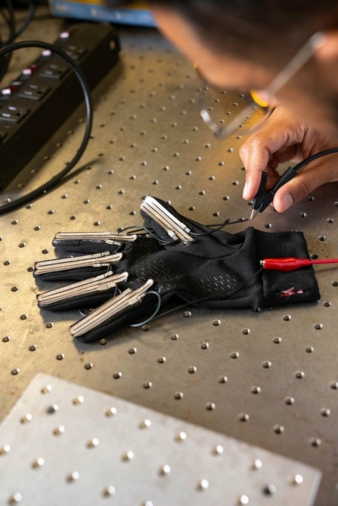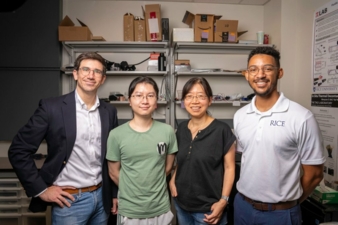19.09.23 – Rice University
You can leave your gloves on
A new material that packs deadly heat for viruses on its outer surface while staying cool on the reverse side could transform the way we make and use personal protective equipment (PPE), cutting down the pollution and carbon footprint associated with current materials and practices.
The composite, textile-based material developed by Rice University engineers uses Joule heating to decontaminate its surface of coronaviruses like SARS-CoV-2 in under 5 sec, effectively killing at least 99.9% of viruses. Wearable items made from the material can handle hundreds of uses with the potential for a single pair of gloves to prevent nearly 20 pounds of waste that would have resulted from discarded single-use nitrile gloves.
“The surge in magnitude of PPE waste and problems caused by supply chain shortages during the pandemic made us realize the need for reusable PPE,” said Marquise Bell, a Rice mechanical engineering graduate student who is the lead author on a study on the material published in ACS Applied Materials and Interfaces. “This work paves the way for a systemic shift away from single-use disposable PPE.”
“The best part is you don`t even need to take off the gloves or other protective garments in order to clean them. This material allows you to decontaminate in seconds, so you can get back to the task at hand.”
Using electrical current, the material rapidly heats up its outer surface to temperatures above 100 °C (212 F), while remaining close to normal body temperature on the reverse side near the user’s skin where it reaches a maximum of about 36 °C (97 F).
“The device has to get hot enough to effectively kill viruses, but not so hot that it causes burns or discomfort for the user,” Bell said. “We included safety mechanisms to make sure the latter doesn’t happen.”
Compared to other decontamination methods, dry heat tends to be both reliable and less likely to damage protective equipment. However, making wearables that heat up to adequate temperatures quickly has required a lot of work.
“Our lab has looked a lot at the thermal inactivation of viruses,” said Daniel Preston, an assistant professor of mechanical engineering who is an author on the study. “We started during the pandemic with support from a National Science Foundation grant, trying to understand the mechanism by which these viruses are inactivated and how it`s accelerated at higher temperatures.”
The earlier research helped lead to the design of the material. Yizhi Jane Tao, a professor of biosciences whose virology lab conducted experiments to confirm the material`s powers of self-decontamination, said she was impressed by how closely experimental data matched predictions.
“We’re very happy that we can contribute our expertise toward this new material,” Tao added. Kai Ye, a graduate student in the Tao lab who helped with the research, said the gloves handled “the infectivity test” well and promise to protect against other similar viruses.
Considering the temperature difference between its outer and inner surfaces, the material is surprisingly supple and lightweight – a feat that feeds directly into Bell’s research focus on smart textile materials.
(Story source: Materials provided by Rice University. Original “You can leave your gloves on: Rice-developed material burns viruses, safe for skin” written by Silvia Cernea Clark. Note: Content was edited for style and length.)


